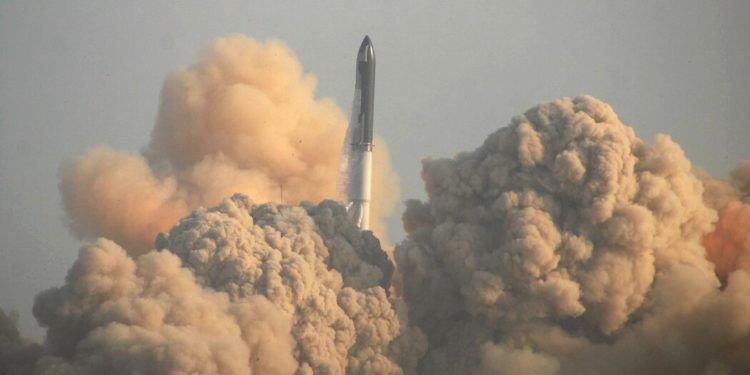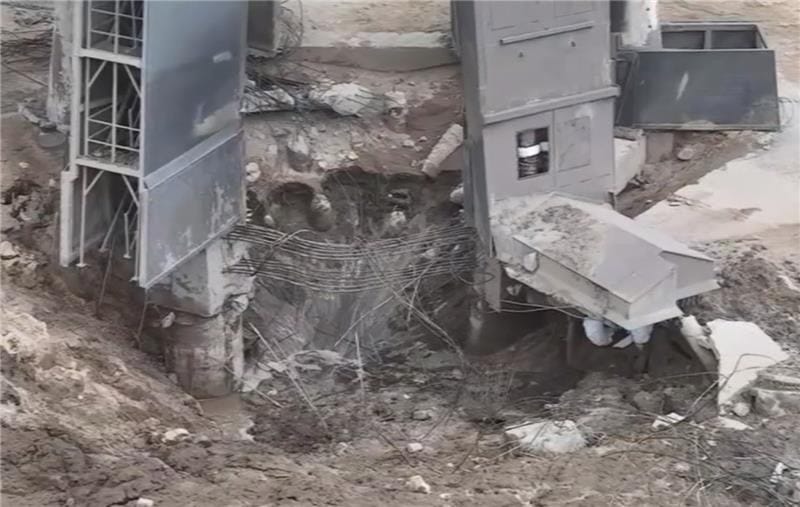The Rocket's Dead Glare
After the explosion, the female narrator, apparently without irony, told the audience, “There, as you saw, and as we promised, an exciting end to the Starship Inaugural Integrated test flight.”

"Let's face it, space is a risky business. I always considered every launch a barely controlled explosion." - Aaron Cohen, NASA Administrator

There was much confusion about the failure of Elon Musk’s launch of the “biggest rocket in history.” When the giant tower of methane fuel rose slowly into the air over the Gulf of Mexico, there appeared to be a defiance of the laws of physics. SpaceX announcers, who often sound more like Hair Club for Men salespeople than engineers and scientists, expressed their enthusiasm as the rocket rose skyward. A more clinical, dispassionate narrative might have been appropriate.
“What a sight,” the male voice chirped. “We’re flying with twice the thrust of the Saturn rocket.”
Well, yeah, but Saturn had thirteen launches, got men to the moon, and never failed. In fact, no Saturn rocket ever failed catastrophically in flight. NASA has launched 166 rockets with only three failures, which included a deadly electrical fire on the pad, and the two Space Shuttle disasters. Rocket science might not have changed dramatically, but skepticism continues to build around SpaceX failures, though the company has successfully landed about 100 of its rockets with a process they call “back boost.” Crashes, however, have become so frequent and numerous that Musk put together a highlight reel of his favorites as his company attempts to develop reusable boosters.
When things began to look less than ideal minutes into the flight of the Super Heavy Lifter from Boca Chica Beach in South Texas, the rocket did not separate from the Starship capsule, and it began to spin out of control.
“Obviously, this is not a nominal situation,” the suddenly less chirpy male voice said.
Quick with a different kind of spin of her own, the female narrator of the launch advised, “I do want to remind everyone that everything after clearing the tower was icing on the cake.”
Upside-down cake, maybe?
Musk has continued to insist that each crash provides new and valuable data to improve future launches, but what is SpaceX learning if its rockets continue to perform acrobatics? After the explosion, the female narrator, Kate, apparently without irony, told the audience, “There, as you saw, and as we promised, an exciting end to the Starship Inaugural Integrated test flight.”
There is truth to her claim. The Falcon Super Heavy Lifter lasted four minutes in flight and cost $3 billion to build, so at less than a billion dollars a minute, hey, that’s an exciting bargain. Musk only gave his Starship a 50 percent chance of reaching orbit and said it faced “great risks and challenges.” Can’t most of those be eliminated with $3 billion dollars? How far does a damn dollar go any more?
The explosion brought a strange moment among staffers gathered to watch the first sight of the Falcon Super Heavy Lifter. There was a brief group expression of awe and then laughter and applause after the explosion was confirmed. The response was about as confusing as Musk’s inconsistent public comportment across his businesses. There is no denying SpaceX has significant achievements by becoming the the first privately-funded company to send a spacecraft to the International Space Station, and the first to launch a commercial ship into orbit around the Earth.
Except that “privately-funded” descriptive is covered in bullshit.
Musk might presently be the planet’s richest human, but he may also be its biggest hypocrite and huckster. When U.S. Sen. Ron Wyden proposed a billionaires’ tax, Musk tweeted, “Eventually, they run out of other peoples’ money and they come for you.” Unmentioned is the fact that if they came for Elon’s money, they’d be recapturing billions in government loans, grants, and tax subsidies his companies have acquired to facilitate their growth and financial success. The ethical contradictions and resplendent hypocrisies are hard to track, but Musk and his empire would likely not exist without corporate socialism and the generosity of mostly unwitting American taxpayers.
During the pandemic, as Musk was tweeting his opposition to government aid for individuals, Tesla accepted “certain payroll benefits” from a $600 million dollar program offered by the feds. While his accountants were adding those benefits to the books, Musk was on Twitter telling America’s struggling families and small businesses, "Another government stimulus package is not in the best interests of the people, imo.”
Even as the entrepreneur, in many ways, still seems to be skinning taxpayers, Time magazine named Musk its “Man of the Year” in 2021. During the interview for the feature, the man who has received billions in government subsidies and tax incentives, spoke out against government subsidies and tax incentives for US businesses. Washington, Musk insisted, is not a good "steward of capital." Even after he was aware that the $1 trillion infrastructure bill President Biden brought into law included $7.5 billion for electric vehicle charging stations, Musk said the government should “just delete” all subsidies from the bill. Except his, of course.
The billions of tax dollars in subsidies, contracts, grants, and loans Musk has received are hard to track because they all come from different agencies and sources. There are, however, sufficient pieces of data to show his hypocrisy is as epic as his wealth. We can start with the Artemis contract with NASA. SpaceX got just under a $3 billion dollar deal to build a human lander and deliver it to the moon. The first touchdown on the lunar surface, without passengers, is supposed to happen in 2025, which may be complicated if the Falcon Super Heavy continues its four-minute performances. The Artemis deal came less than a year after the US Air Force gave Musk a $653 million dollar contract to deliver military satellites into Earth orbit.
Here in Texas, between Travis County and the Del Valle Independent School District outside Austin, Musk has agreed to $60 million in tax abatements, a shortfall that will be picked up by homeowners elsewhere in the state paying their taxes into the school finance system. Further, the land where his giga-factory has been built will never be taxed at a valuation of more than $80 million dollars, by agreement, which means his tax bill will be about $4.6 million less annually than the apparent value of his facility.
Down at the tip of Texas, Musk is also doing quite well on tax kickbacks at the Boca Chica “Starbase” where he launches and blows up rockets. Cameron County commissioners gave him a ten-year abatement on property taxes, and his rocket launch and production facility has been provided with more than $13 million by the state’s Space Port Development Corporation. Musk and Jeff Bezos are both believed to be taking advantage of the previous US president’s Opportunity Zone tax breaks, which are supposed to assist underdeveloped areas like Brownsville. Unfortunately, the feds require almost no reporting so taxpayers have no real understanding of what is happening in the OZ’s, other than they appear to getting leveraged for big dollars by corporations like SpaceX.
As good as he is at getting astronauts and satellites into earth orbit, Musk might be better at the government grift. An organization called the “Subsidy Tracker” reports that SpaceX has received at least $106 million dollars of loans, subsidies, grants, and bailouts, which we paid for with your money. For the capital he gets from the capitol, one might be inclined to believe he’d abide by federal regulations but Musk sent one rocket heavenward without a license, which was the first time that has happened in US history. When asked about his violation of rules, Musk made it sound like they simply did not apply to his company.
“Their rules are meant for a handful of expendable launches per year from a few government facilities. Under those rules, humanity will never get to Mars.”
We might not get there with SpaceX, either. Test launches of the heavy rocket began two years ago and there have now been five flights and five explosions, with one booster landing before blowing up. This might shorten the line of ticket buyers to Mars, and maybe humanity’s not in as big a hurry as Musk. We’ll go as soon as he figures out how to “fold space” and then grow trees on the red planet. Also, a place that makes good breakfast tacos will be a Mars essential.
Musk, meanwhile, is trying to turn Brownsville and Boca Chica into a new kind of company town. He announced a plan to donate millions to area schools and the downtown revitalization efforts of Brownsville, historically one of the nation’s lowest income communities. Although thousands of jobs were predicted in economic projections to earn the tax break approvals, the latest count is about 500 direct and 1200 indirect jobs since the 2014 start of the SpaceX project.
In Boca Chica, which is home to a few dozen families, he is trying to encourage all property owners to sell to SpaceX. Several have sold because Musk has said he wants to turn the little beach community into a new town he will call Star Base. The people who found the once-remote spot next to the Gulf of Mexico are being overwhelmed with traffic and construction noise and in the days before launches are given notices advising it would be safest if they vacated until the rocket was back on the pad, assuming it gets back to the pad. Must make backyard barbecues more exciting in a little cluster of homes that used to give off the vibe of a lost fish camp down at the bottom of America.
The area around the launch pad, almost unbelievably, is environmentally sensitive and near the Lower Rio Grande Valley National Wildlife Refuge, which is home to countless endangered species. The habitat is nearly unique in the northern hemisphere. The American Bird Conservancy (ABC) told the FAA and the EPA that the “ecological importance of this region cannot be overstated.” The group says the beach and surrounding estuaries are home to many declining wildlife species.
In appealing for a new and comprehensive environmental impact study, (EIS), before allowing increased launches of larger rockets, the ABC wrote that, “Boca Chica State Park, Brazos Island State Park, and Las Palomas Wildlife Management Area-Boca Chica Unit all surround the SpaceX site. These conservation areas are home to some of the country’s most diverse communities of wind tidal flats, mid-delta thorn forest, and mid-valley riparian woodlands that support rare, endangered, and threatened species, making it critically important to ensure impacts to these natural resources are minimized.”
Impacts of the giant rockets were not included in the original EIS. The data were prepared based on the smaller craft and engines, and fewer flights and test firings, which is an indication that SpaceX did not qualify for its expedited launch schedule. The only way that could have happened was if, according to the FAA, “Data and analytics contained in the previous EIS are still substantially valid and there are no significant new circumstances or information relevant to environmental concerns and bearings on Proposed Action or its impacts.” That was not the case since the 2014 EIS apparently did not consider increased frequency and size of craft being launched and there have been substantial changes to the initial project since it was authorized. A supplemental EIS should have been conducted when FAA regulations are considered. In short, the giant rocket should never have been cleared for launch by the federal government.
In its complaint to the FAA, the American Bird Conservancy wrote, “The initial project that was authorized in 2014 allowed for up to 12 launches of Falcon 9 or Falcon Heavy rockets each year. Instead, the mission has changed to one of testing of various components and rockets/vessels including the Starship and Super Heavy, which are nearly ten times the mass, requiring far greater fuel loads and thrust and fuel that is more volatile and explosive than the Falcon 9.”
Animals clearly can’t complain but there are some unhappy humans down where the Rio Grande meets the sounding sea. Complaints were endless and angry as debris and dust and particulate matter covered vehicles and homes from South Padre Island to Port Isabel and into Brownsville. In Port Isabel, one resident described the sound and vibrations as “truly terrifying,” and a spokeswoman for the city, Valerie Bates, said the entire community, “ended up with a covering of a rather thick, granular, sand grain that just landed on everything.” If the decibel levels never before heard in that part of the world are high enough to frighten sentient Texans, imagine what they do to nesting and migrating birds.
LabPadre’s Louis Balderas has been filming SpaceX’s launches and told DYNUZ that Thursday’s liftoff was unlike anything he had ever seen.
“There were bowling ball-sized pieces of concrete that came flying out of the launchpad area,” he said. Balderas indicated that the blast had created a crater he estimated was around 25 feet deep. A picture posted to a social media site that follows SpaceX showed the launch pad almost destroyed by the Super Heavy’s engine thrust. Musk’s team had not even calculated the potential impact on their own infrastructure, much less what might happen in the surrounding communities.

There are times when I think the only real reason to get off this planet is to get away from people like Elon Musk.